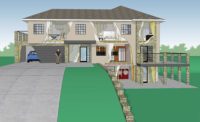I often see gypsum board installed using a combination of nails and screws, and I’ve always assumed this practice is acceptable. However, one of my superiors recently questioned the practice. Is combining nails and screws acceptable?
According to GA-216-2010 (Application and Finishing of Gypsum Panel Products), the practice is acceptable with the addition of one caveat that does not appear in the text.
Section 5.5 of GA-216 allows the use of a combination of fasteners, consisting of nails along the perimeter and screws in the field of the board, in a standard, non-fire-resistive installation of gypsum board. In fact, this is a fairly common residential application practice in some parts of the United States and Canada.
However, one must be careful with this practice when a fire-resistive system is involved. Fire-resistive gypsum panel systems are not typically tested using a combination of screws and nails, so correlation of this practice to a tested system in the field is next to impossible. It is very important to follow the details of the tested system when installing fire-resistive systems. Nonetheless, it is well-documented that one can substitute a screw for a nail in a fire-tested system as long as the screw is equal to or greater in length and head diameter than the specified nail. For example, if the tested system calls for nails, you can substitute screws for the nails in the field of the board, and this will not adversely impact the fire-resistive ability of the test. Just make sure the substitution is done one-for-one so the screws are spaced as the nails would have been.
It is important to note that the converse of the above-mentioned example is not acceptable. In other words, if the original system was tested using screws and you replace some of the screws with nails, then the system may not pass the fire test. This is largely due to screw heads being larger than nail heads, which provides a larger fastener to the bearing surface supporting the board.






Report Abusive Comment